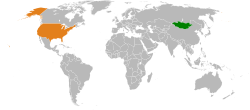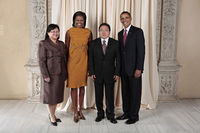- Mongolia–United States relations
-
Mongolia – United States relations 

Mongolia
United StatesMongolia – United States relations are bilateral relations between Mongolia and the United States.
Contents
History
The U.S. Government recognized Mongolia in January 1987 and established its first embassy in Ulan Bator in June 1988. It formally opened in September 1988. The first U.S. ambassador to Mongolia, Richard L. Williams, was not a resident there. Joseph E. Lake, the first resident ambassador, arrived in July 1990. Secretary of State James Baker visited Mongolia in August 1990, and again in July 1991. Mongolia accredited its first ambassador to the United States in March 1989. Secretary of State Madeleine Albright visited Mongolia in May 1998, and Prime Minister Nambaryn Enkhbayar visited Washington in November 2001. Deputy Secretary of State Richard L. Armitage visited Mongolia in January 2004, and President Natsagiin Bagabandi came to Washington for a meeting with President George W Bush in July 2004. President Bush, First Lady Laura Bush, and Secretary of State Condoleezza Rice visited Mongolia in November 2005.[1] Defense Secretary Donald Rumsfeld visited in October 2005 and Speaker of the House of Representatives Dennis Hastert visited Mongolia in August 2005. Agriculture Secretary Mike Johanns led a presidential delegation in July 2006 in conjunction with Mongolia's celebration of its 800th anniversary. President Enkhbayar visited the White House in October 2007 and the two Presidents signed the Millennium Challenge Compact for Mongolia (see below).
The United States has sought to assist Mongolia's movement toward democracy and market-oriented reform and to expand relations with Mongolia primarily in the cultural and economic fields. In 1989 and 1990, a cultural accord, Peace Corps accord, consular convention, and Overseas Private Investment Corporation (OPIC) agreement were signed. A trade agreement was signed in January 1991 and a bilateral investment treaty in 1994. Mongolia was granted permanent normal trade relations (NTR) status and generalized system of preferences (GSP) eligibility in June 1999. In July 2004, the U.S. signed a Trade and Investment Framework Agreement with Mongolia to promote economic reform and more foreign investment. In July 2007, six members of the U.S. House of Representatives visited Mongolia to inaugurate an exchange program between lawmakers of the two countries. The return visit came in August 2007, with five members of the Mongolian Parliament traveling to the U.S. In September 2007, the White House announced the proposed creation of an Asia-Pacific Democracy Partnership, in which Mongolia was invited to take part. The initiative is aimed at providing a venue in which free nations can work together to support democratic values, strengthen democratic institutions, and assist those who are working to build and sustain free societies.
US Assistance
The U.S. Agency for International Development (USAID) plays a lead role in providing bilateral development assistance to Mongolia. The program emphasizes one major theme: sustainable, private sector-led economic growth and more effective and accountable governance. Total USAID assistance to Mongolia from 1991 through 2008 was about $174.5 million, all in grant form. USAID Mongolia's FY 2007 budget of $6.625 million a year promotes: a) economic growth by focusing on activities that support macroeconomic policy reform, energy sector restructuring, financial sector reform, and micro and small enterprise development; and b) governing justly and democratically by focusing on activities supporting judicial sector reform, electoral reform, parliamentary reform, and anti-corruption.
In most years since 1993, the United States Department of Agriculture has provided food aid to Mongolia under the Food for Progress and 416(b) programs. The monetized proceeds of the food aid ($4.2 million in 2006) are currently used to support programs bolstering entrepreneurship, herder livelihood diversification, and better veterinary services.
The United States has also supported defense reform and an increased capacity by Mongolia's armed forces to participate in international peacekeeping operations. Mongolia has contributed small numbers of troops to coalition operations in Iraq and Afghanistan since 2003, gaining experience which enabled it to deploy armed peacekeepers to both UN and NATO peacekeeping missions in 2005. With U.S. Department of Defense assistance and cooperation, Mongolia and the U.S. jointly hosted "Khan Quest 06," the Asian region's premier peace-keeping exercise, in the summer of 2006 and "Khan Quest 07" a year later. All of the 100 Mongolian troops withdrew from Iraq on September 25, 2008 allegedly due to the huge pressure put upon by both the Russians and the Chinese.
The Peace Corps has approximately 100 volunteers in Mongolia. They are engaged primarily in English teaching and teacher training activities. At the request of the Government of Mongolia, the Peace Corps has developed programs in the areas of public health, small business development, and youth development. In 2005 and 2006 Mongolian Government officials, including President Enkhbayar and Prime Minister Tsakhiagiin Elbegdorj, requested significant increases in the number of volunteers serving in country. The Peace Corps has responded with a commitment to make modest annual increases until 2010. The program celebrated its 15th anniversary in 2006 with participation by President Enkhbayar.
The Millennium Challenge Corporation (MCC) completed negotiations for a Compact with Mongolia [2] in 2007 and the Compact was signed at the White House in October 2007.[3][4] The Compact calls for $285 million to be spent on four projects over a five-year period beginning in July 2008. The four projects are an upgrade to the railroad in Mongolia, the main economic lifeline of the nation, an improvement in the vocational education program, assistance to the Mongolian health services, and a project designed to assist Mongolians to register their property with the government.
In August, 2011, on a side trip while traveling to China and Japan, Joe Biden made the first visit by a sitting vice president to Mongolia since Henry Wallace made one in 1944.[5][6]
Economic interests
In March, 2011, six mining companies including Peabody of St. Louis, Missouri were preparing a bid for the Tavan Tolgoi area, the location of a substantial coking coal deposit.[7]
Biden's 2011 visit, according to Richard C. Bush of the Brookings Institute, may be able to encourage Mongolia's democracy and U.S. relations in the face of both Mongolia's predominantly natural-resource-driven political economy (where "funny things [can] happen") and its two powerful landlocking neighbors, China and Russia.[5]
Diplomatic Missions
Jonathan Addleton was appointed Ambassador to Mongolia 11/09/2009.[8] Mark C. Minton was the U.S. Ambassador to Mongolia from 2006 to 2009, succeeding Pamela J. H. Slutz.
The Mongolian Ambassador to the U.S. since April 9, 2008 has been Khasbazaryn Bekhbat.[9]
References
- ^ http://georgewbush-whitehouse.archives.gov/news/releases/2005/11/20051121-1.html
- ^ http://www.mcc.gov/documents/factsheet-102207-mongolia.pdf
- ^ http://www.voanews.com/english/archive/2007-10/2007-10-23-voa2.cfm?CFID=207663617&CFTOKEN=61033568&jsessionid=6630fc86cd81feeba7148336526a30203c16
- ^ http://www.usatoday.com/news/washington/2007-10-22-2067418468_x.htm
- ^ a b Robb, Greg, "The subtleties of Biden’s trip to Mongolia", MarketWatch, August 16, 2011, 11:10 AM EDT. Biden will also be visiting Japan on the trip.("Vice President Biden to Travel to China, Mongolia, and Japan", White House statement, August 04, 2011.) Retrieved 2011-08-16.
- ^ "Joe Biden Takes on Mongolian Wrestlers [PHOTOS"], International Business Times, August 23, 2011 11:22 AM EDT. Retrieved 2011-08-25.
- ^ Jin, Hyunjoo and David Stanway, "UPDATE 6-ArcelorMittal, Vale vie for huge Mongolia coal mine", Reuters, Mar 7, 2011 3:56am EST. Retrieved 2011-08-16.
- ^ "Biography: Jonathan Addleton", U.S. Department of State website. Retrieved 2011-08-16.
- ^ "H.E. Mr. Khasbazaryn BEKHBAT", Mongolian Embassy, Washington, D.C. website. Retrieved 2011-08-16.
 This article incorporates public domain material from websites or documents of the United States Department of State (Background Notes).[1]
This article incorporates public domain material from websites or documents of the United States Department of State (Background Notes).[1]External links
Bilateral realtions Bulgaria · Canada · China · Croatia · Czech Republic · Egypt · India · Japan · North Korea · Norway · Russia · South Korea · Taiwan (ROC) · United States · VietnamDiplomacy Diplomatic missions of / in Mongolia Foreign relations of the United States
Foreign relations of the United StatesBilateral relations Africa Algeria · Angola · Benin · Botswana · Burkina Faso · Burundi · Cameroon · Cape Verde · Central African Republic · Chad · Comoros · Democratic Republic of the Congo · Republic of the Congo · Côte d'Ivoire (Ivory Coast) · Djibouti · Egypt · Equatorial Guinea · Eritrea · Ethiopia · Gabon · The Gambia · Ghana · Guinea · Guinea-Bissau · Kenya · Lesotho · Liberia · Libya · Madagascar · Malawi · Mali · Mauritania · Mauritius · Morocco · Mozambique · Namibia · Niger · Nigeria · Rwanda · São Tomé and Príncipe · Senegal · Seychelles · Sierra Leone · Somalia · South Africa · South Sudan · Sudan · Swaziland · Tanzania · Togo · Tunisia · Uganda · Zambia · ZimbabweAsia Middle East Bahrain · Egypt · Iran · Iraq · Israel (Military relations) · Jordan · Kuwait · Lebanon · Oman · Qatar · Saudi Arabia · Syria · United Arab Emirates · YemenElsewhere Afghanistan · Bangladesh · Bhutan · Brunei · Burma · Cambodia · People's Republic of China (Hong Kong · Macau) · East Timor · India · Indonesia · Japan · Kazakhstan · Kyrgyzstan · Laos · Malaysia · Maldives · Mongolia · Nepal · North Korea · Pakistan · Philippines · Russia · Singapore · Sri Lanka · South Korea · Republic of China (Taiwan) · Tajikistan · Thailand · Turkmenistan · Uzbekistan · VietnamEurope Albania · Andorra · Armenia · Austria · Azerbaijan · Belarus · Belgium · Bosnia and Herzegovina · Bulgaria · Croatia · Cyprus · Czech Republic · Denmark · Estonia · Finland · France · Georgia · Germany · Greece · Hungary · Iceland · Ireland · Italy · Kosovo · Latvia · Liechtenstein · Lithuania · Luxembourg · Macedonia · Malta · Moldova · Monaco · Montenegro · Netherlands · Norway · Poland · Portugal · Romania · Russia · San Marino · Serbia · Slovakia · Slovenia · Spain · Sweden · Switzerland · Turkey · Ukraine · United Kingdom (Special Relationship) · Vatican CityNorth America Caribbean Antigua and Barbuda · Aruba · Bahamas · Barbados · Bermuda · Cayman Islands · Cuba · Dominica · Dominican Republic · Grenada · Haiti · Jamaica · St. Kitts and Nevis · St. Lucia · St. Vincent and the Grenadines · Trinidad and TobagoElsewhere Belize · Canada (Trade) · Costa Rica · El Salvador · Guatemala · Honduras · Mexico · Nicaragua · PanamaOceania ANZUS Australia · New ZealandElsewhere Fiji · Kiribati · Marshall Islands · Micronesia · Nauru · Palau · Papua New Guinea · Samoa · Solomon Islands · Tonga · Tuvalu · VanuatuSouth America Argentina · Bolivia · Brazil · Chile · Colombia · Ecuador · Guyana · Paraguay · Peru · Suriname · Uruguay · VenezuelaFormer states Kingdom of Hawaii · Netherlands Antilles · Republic of Texas · Russian Empire · Soviet Union
Multilateral relations Arab League · European Union · Latin America · Africa · United Nations · Third Border Initiative · International organizationsDoctrines, policies, concepts Presidential
doctrinesProclamation of Neutrality · Monroe · Roosevelt Corollary · Good Neighbor policy · Truman · Eisenhower · Kennedy · Johnson · Nixon · Carter · Reagan · Clinton · Bush · ObamaOther doctrines Policies and
conceptsCategories:- Bilateral relations of the United States
- Bilateral relations of Mongolia
- Mongolia–United States relations
Wikimedia Foundation. 2010.


